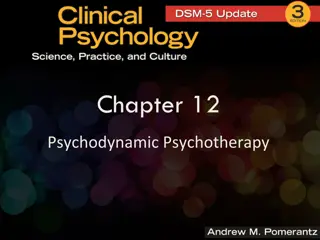Understanding Psychoanalysis: Unconscious Dynamics and Mental Health
Psychoanalysis, as pioneered by Sigmund Freud, delves into the dynamic interactions between the conscious mind and the unconscious, exploring hidden conflicts, desires, and fears. By examining symptoms, dreams, and neuroses, psychoanalysis seeks to bring repressed memories and concerns into consciousness to promote healing and self-awareness. The concept of the unconscious challenges traditional views of self-knowledge, emphasizing the importance of addressing suppressed emotions and drives for mental well-being.
Download Presentation

Please find below an Image/Link to download the presentation.
The content on the website is provided AS IS for your information and personal use only. It may not be sold, licensed, or shared on other websites without obtaining consent from the author. Download presentation by click this link. If you encounter any issues during the download, it is possible that the publisher has removed the file from their server.
E N D
Presentation Transcript
What is psychoanalysis? NOT: psychology (the conscious operations of the mind or cognitive science (mind s neural architecture), BUT dynamic interactions between the conscious mind and the unconscious, and the human subject and its social environment. Psychology, sexology, psychiatry, literary criticism, dream interpretation and Freud s clinical practice
Sigmund Freud (1856-1939) The Unconscious The conscious mind is only one component of the self. He discovered the unconscious by examining the symptoms of mental illness and ordinary dreams: conflicts, concerns, desires, and fears to emerge into consciousness. Symptoms: clues to memories or concerns that had been banished from consciousness. Dreams: unconscious material manifests itself. Subconscious is not a Freudian term (ego psychology).
The Unconscious 2 Shattered the Cartesian model of the self who was capable of self-knowledge. The idea of a shadow self or hidden self appeared in a variety of forms, including Stevenson s Dr. Jekyll and Mr. Hyde (1886) uncontrollable bloodthirsty monster of sex and violence. Psychic energy is expended in guarding the gates of the unconscious, causing neurosis, which as a medical doctor he hoped to cure. His method involved bringing the contents of the unconscious into consciousness through talking. To reduce the need for repression by having the ego or conscious mind look at and accept the libidinal drives contained in the unconscious. Wo es war, soll ich werden: where it was, shall I be.
Early Topography The ego (consciousness and the individual s contact with the external world) and the unconscious (instinctual drives, sexual energy [ libido ] and repressive mechanisms. The two occupied different areas and the problem was to understand how libidinal energy moved between the two. 2 instincts - sexual instinct (~fantasy, wish fulfilment), ego (consciousness) corresponding to 2 principles: pleasure principle and reality principle.
Neuroses Much of Freud s early work centred around the analysis of neurotic symptoms (particularly hysteria), derivatives of memories that had been repressed and existed only in the unconscious. Neuroses are psychological disorders involving issues between self and world; they include hysteria, obsessive and compulsive disorders, depression, phobias and so on; they are the focus of psychoanalysis and can be treated. Psychoses are more serious disorders, often with an organic basis, that involve a breakdown of some kind in the balance between conscious self and unconsciousness and are typically not treatable by psychoanalysis. (The most common psychoses are schizophrenia and bipolar disorder.)
Dreams Like the symptom, the dream is an indirect or coded message, the interpretation of which holds the key to the meaning of the dream. Manifest dream content: the dream itself, the object of interpretation. Latent content: the actual thought that cannot be known or expressed consciously because it has been repressed or censored . Dream-work : unconscious material is allowed a disguised or coded expression. This dream-work entails the primary mechanisms of displacement [metaphor] and condensation [metonymy].
Sexual Development Dreams hold the key to neurotic symptoms that usually originate in an individual s earliest experiences of instinctual satisfaction and repression. Sexual development is interrupted by a latency period that effectively separates it into two distinct phases, pre-genital (oral and anal states) and genital, each incorporating multiple stages and, quite often, regressions to prior stages. Children are polymorphously perverse and can respond along a number of erotic pathways to a number of sexual objects (including the child him or herself). Normal development entailed the integration of perversions into a healthy, heterosexual instinct (reproduction).
Oedipus Complex The young male child desires his mother, but feels thwarted by the father. The father is perceived as a threat to the child s bond with the mother, akin to a fear of being castrated. A normal dissolution of the Oedipus complex would involve the male child repudiating his mother and identifying with his father. His desire must now find another object. For young girls, this process is doubly traumatic, for girls must not only turn away from their initial love object, they must also shift their desire from female to male objects. The Oedipus complex installs repression as a means by which to manage Super ego emerges as a result of a successful Oedipal experience.
Father Nuclear family, nurturing mother, father authority figure. After the dissolution of the Oedipal Complex, the father s authority and power are internalized in the creation of the conscience or superego, while the desire for the mother is repressed, thus creating the unconscious. In Lacan, Father refers to a structural position rather than to a specific person. The Father, or The Name of the Father, or The Law of the Father or even the Phallus is how Lacan refers to the position that serves as a centre in the Symbolic Order.
Structural theory of the mind The Uncanny (1919), Beyond the Pleasure Principle (1920), The Ego and the Id (1923) [aftermath of WW1] The ego, the superego, and the id (his new term for the unconscious) Subsumes the ego and sexual instincts into a single sexual instinct towards self-preservation (Eros) and offers a new category, the death instinct (Thanatos).
The Uncanny Freud bringing psychoanalysis into dialogue with literary criticism, philology, cultural anthropology. Strange and anxious feeling sometimes created by familiar objects in unfamiliar contexts modernist, surrealist art . 1) German words heimlich and unheimlich; 2) examination of E.T.A. Hoffmann s "The Sandman" (1817) and a discussion of the experience of the uncanny. 3) effect of the uncanny, esp. in literature and fiction.
The Uncanny 2 heimlich, first definition = I, a: belonging to the house; friendly; familiar; I, b: tame (as in animals); I, c: intimate, comfortable; i.e: secure, domestic(ated), hospitable. heimlich, second definition = concealed, secret, withheld from sight and from others; secretive, deceitful = private. unheimlich I = unhomey, unfamiliar, untame, uncomfortable = eerie, weird, etc. unheimlich II (the less common variant) = unconcealed, unsecret; what is made known; what is supposed to be kept secret but is inadvertently revealed.
The Uncanny 3 In dreams, myths, neurotic fantasies, etc. loss of the eyes = fear of castration. The uncanny arises due to the return of repressed infantile material or surmounted primitive beliefs of the human species, such as animism. The double (Doppelg nger); primary narcissism produces projections of multiple selves, by doing this the child insures his/her immortality. But only in realistic fiction where we can share the character s experience.
Jacques Lacan (1901-81) A return to Freud opposed to ego-psychology. Highly trained in philosophy, associated with surrealists like Georges Bataille, Salvador Dali, and Pablo Picasso. Combining Freud s idea of the Oedipus Complex as a cultural universal with L vi-Strauss universal structures of myth as language, Lacan articulated the idea of the unconscious as structured like a language (as understood by Saussurean linguistics).
The Unconscious The unconscious is like a signified that belongs to an entirely different realm from signifiers, such as dreams and symptoms. It can be indicated by signifiers but never reached. Chain of signifiers at the origin of the chain is something unattainable: fused state of the child with the mother, which fostered a quasi- narcissistic sense of a pleasurable plenitude, a unity of self and other.
The Unconscious 2 Freud s rampant libidinal drives in Lacan s version become shifting signifiers, which constantly slide around each other, making any kind of definitive meaning impossible (this before Derrida s diff rance). Concepts like I (identity, ego, self) have no meaning. The conscious mind, the self that says I, is an illusion created by the unconscious during the mirror stage.
The Other Like the linguistic system that is a context that gives meaning to an individual word, the Other in psychoanalysis is the field of social relations, unconscious processes, and forms of signification that define the individual self. The Other tends to take on authority, even divinity. The individual human subject is delusional and imagines itself to be a self-determining identity, the purpose of Lacanian analysis is to free the subject from its attachment to fantasy (the ego) by encouraging it to come to terms with its place within the larger structure that is the Other.
The mirror stage/phase Marks the moment when a child distinguishes his or her body from its reflected image. To be added to the sequence of Freud s oral, anal, and phallic stages. Lacan later introduced the acquisition of language as an additional important factor in the development of the self: Language cancels the immediacy of perception, so that the acquisition of a symbol-making capacity occurs simultaneously with separation from the early attachment to the mother.
The mirror stage/phase The function of nomination (or naming) arises at this stage, especially when exercised by the father, whose structural role is to lay down the law, in the first instance by breaking the developmental fusion of the mother and the child. Commensurate with this stage is a shift from the No! of the father (le non du p re) to the name of the father (le nom du p re). The symbol replaces perceptual experience and comes to stand in for the absent fusion with the mother. By substituting for the thing (the mother s body), the symbol frees the child to develop as a separate being.
The Real The infant has no perception of itself as a separate individual; rather, is aware only of its needs and the satisfaction of those needs. There is no language or need for representation because what the baby needs is always there. Must be abandoned to become a language-using speaking, separate subject. A threat to the stability of the Symbolic Order. In feminist theory is often associated with the maternal body, which must be renounced in order to gain entry to language in the Symbolic Order; the Phallus as centre of the Symbolic is thus established against, and in fear of, the realm of the Real.
The Imaginary One of three realms a child must pass through to become a linguistic speaking Subject. When the child begins to use images for its psychological development such as internalizing an image of a face it enters the Imaginary realm. Within the Imaginary, the child experiences the mirror phase, it internalizes an Imaginary specular image of a whole body, which comes to replace its fragmentary experience of its own body parts (mis-recognition). The visual or specular self internalized in the Imaginary becomes the basis for the linguistic speaking self the self who says I in the Symbolic Order.
The Symbolic Realm/Order Transition of the primitive infant into a civilized adult who can represent itself and its world through symbols, specifically through the combination of signifiers and signifieds that create stable signs. Freud s idea of the resolutions of the Oedipus Complex, Levi-Strauss idea of symbolic exchange as a structuring principle of all cultures, and de Saussure s idea of linguistic representations. The transition from the Imaginary into the Symbolic is always incomplete. Child s ability to name that image of itself, its ego-ideal, as me or I. Putting a linguistic signifier the sound- image I together with the concept of self as an integrated bounded whole completes the sign that, in language, means selfhood.
The Symbolic 2 Participation requires that the language using subject comes under the authority of the Phallus, which is the centre of the Symbolic Realm. The subject is constituted as lack or absence, and feels constant (and unfulfillable) desire to occupy the central position of the Phallus. Unlike the humanist concept of the self as creating its own meaning, the subject within the Symbolic is subjected to the rules of language; meaning is a product not of the individual but of the structure of language and of culture itself. A person enters the Symbolic Order and takes up a subject position in relation to the Phallus (the transcendental signified, the ultimate source of the meaning of the signifiers being exchanged).
Castration In Freud, castration is the ultimate fear, as a boy s narcissistic ego is invested in his penis as his primary source of pleasure. Penis envy for females: a girl who discovers she is already castrated, desperately wants to obtain a penis of her own to make up for her lack. In Lacanian, this becomes the power of the Phallus or Name of the Father, the position of full presence or completeness in the centre of the Symbolic; all language- using subjects in the Symbolic are constituted by lack. Feminist theories use these ideas to discuss the possibilities for a feminine language that comes more directly from the unconscious, ungoverned by the Freudian superego or the Lacanian Phallus.
Slavoj iek (b. 1949) Slovenian philosopher, combines psychoanalysis, philosophy, and politics. studied psychoanalysis at the University of Paris VIII with Lacan s son-in-law Jacques- Alain Miller. More than 40 books. Ran for president in 1990. Known for an iconoclastic style combining high and low culture.
The marriage of Lacan and Hegel Focuses on the connection btw the Symbolic and the Real and presents the Real as what the Symbolic both depends on and is constantly threatened by. This, based on a radical interpretation of Hegel that stresses not the conclusion of the dialectical process (the absolute idea, totality) but the process of negation (every thesis necessarily provoking an antithesis).
Marrying psychoanalysis and Marxism Marxist definition of ideology as false consciousness refers to a set of beliefs, values, morals, and assumptions that are presented as natural but only serve the interests of the dominant social groups. For i ek, ideology functions through the social organization of jouissance (Lacan): sexual enjoyment individuals have an irresistible urge toward yet have to compromise once they enter the socio-symbolic order. Political regimes will only perpetuate their ideology by organizing their subjects relations to jouissance (for example, through music, drugs, alcohol, festivals, etc.). (Suppression can be experienced as pleasure.)























